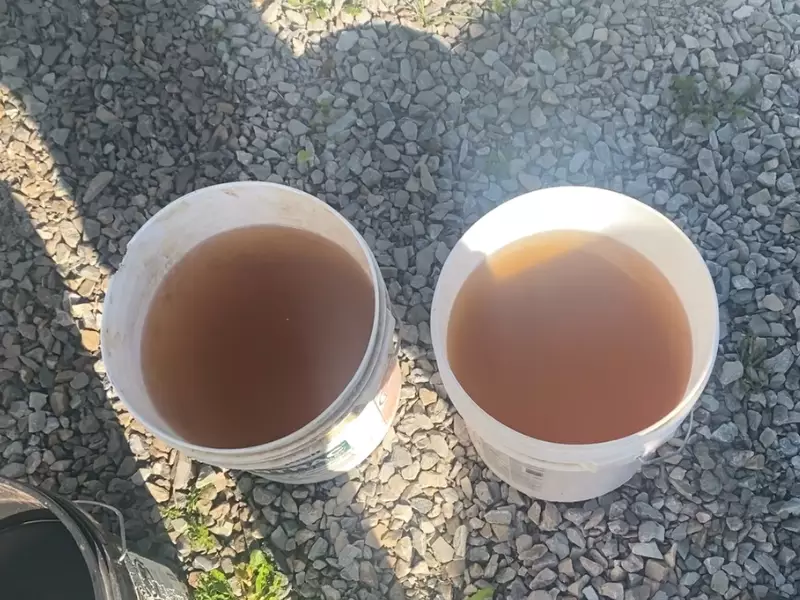Brown well water is a common issue faced by households relying on groundwater for their daily needs. While the appearance can be alarming, understanding the root causes helps mitigate concerns and find effective solutions.
Brown water primarily arises from natural mineral content, corroding plumbing, nearby disturbances, or bacterial presence. Ensuring clean water is crucial for the health and well-being of households.
Addressing the issue of brown well water necessitates a combination of prevention and treatment measures. These steps not only safeguard the health of the residents but also protect the longevity of plumbing systems.
Brown Water Causes
Water discoloration can be perplexing and worrying, especially when the source of the water is a well relied upon for daily needs. Several factors might be responsible for the brown tinge in well water. Let’s explore these in more detail.

Natural Mineral Content
Groundwater, unlike treated municipal water, directly extracts from natural sources. This means it often comes in contact with soil, rocks, and underground minerals.
- Iron: One of the most prevalent minerals in the ground, especially in certain geographical locations. When water interacts with regions high in iron content, it naturally dissolves some of the iron, leading to a reddish-brown tint. While typically not harmful for consumption, excessive iron can impart a metallic taste.
- Manganese: Less common than iron but equally potent in causing discoloration. Water with high manganese content can appear slightly blackish. Consuming water with high manganese levels over prolonged periods isn’t advisable due to potential health implications.
Corroding Plumbing Systems
The internal condition of plumbing systems plays a crucial role in the quality of water.
- Old Pipes: In older houses, the plumbing might be decades old, and the pipes may be made of materials prone to corrosion. Over time, as these pipes deteriorate, they release rust and other metals into the water, causing discoloration.
- Rust Development: Even in newer plumbing systems, if there’s a presence of oxygen and the material is iron or iron-based, rust can develop. Rust not only discolors the water but might lead to plumbing issues down the line.
Nearby Construction or Disturbances
Our environment is in a state of constant change. When there are external disturbances, it can impact the quality of groundwater.
- Soil Disruption Effects: Construction activities, especially those requiring deep excavations, can disrupt the soil layers. This can lead to sediment being introduced to the water table, which in turn can find its way into your well, causing a brown tint.
- Aquifer Shifts: Natural phenomena like earthquakes or human-made disruptions can shift aquifers (underground layers of water), leading to a mix of previously separated water layers. Such events might introduce new minerals or sediments to your well water.
Presence of Bacteria
While the thought of bacteria in water is unsettling, it’s not uncommon, especially in well water systems.
- Iron Bacteria: This is a natural part of the environment and thrives in places with high iron content. They feed on the iron, leading to the formation of a brown or reddish slime. This slime can give water its brown color. Aside from the unappealing appearance and taste, a high concentration of iron bacteria can clog wells and plumbing systems.
- Organic Decomposition: Sometimes, organic matter (like leaves, plants, or even small animals) can find its way into wells. As they decompose, they might discolor the water and also lead to bacterial growth.

Health Implications
Whenever water quality changes, the primary concern is often the potential health risks associated. Let’s dive into what brown well water implies for your health.
Safety of Consuming Brown Water
Brown water caused solely by minerals like iron and manganese isn’t typically harmful when consumed in moderate amounts. However:
- Iron, although essential for the body, in excessive amounts can lead to health problems like hemochromatosis. Symptoms include fatigue, joint pain, and abdominal pain.
- Manganese, while a trace mineral needed for healthy functioning, can be neurotoxic in high concentrations. Long-term consumption of water rich in manganese can lead to neurological issues.
- Bacterial Contamination: If the brown color results from bacterial growth, consuming such water is risky. It can lead to gastrointestinal problems, infections, and other health complications.
Skin and Hair Effects
Water quality directly impacts skin and hair health. Using brown well water can lead to:
- Dryness: Minerals can make water “hard,” leading to skin dryness and irritation after showers. Hard water also doesn’t lather well with soaps, making cleaning less efficient.
- Hair Issues: Washing hair with mineral-rich water can leave it feeling limp, dull, and lifeless. Over time, it can also lead to discoloration, especially for people with lighter hair colors.
Testing Brown Well Water
Before jumping to solutions, it’s essential to understand the exact cause of the discoloration. Testing the water is the first step in this process.
Importance of Regular Water Tests
Water tests aren’t just about color. They help in:
- Identifying Contaminants: From harmful bacteria to excessive minerals, tests provide a breakdown of what’s in your water.
- Guiding Treatment: Knowing the exact issues allows for targeted treatment, ensuring efficient and cost-effective solutions.
DIY Kits vs. Professional Testing
There are multiple ways to test water quality:
- DIY Kits: Convenient and quick, these kits offer instant results for specific contaminants like iron or pH levels. However, they might not provide a comprehensive analysis.
- Professional Testing: If you’re looking for a detailed breakdown of your water quality, sending a sample to a lab is the best approach. They can test for a wide range of contaminants, providing a clearer picture of water quality.
Prevention Strategies
Brown well water isn’t inevitable. With the right strategies, you can prevent or significantly reduce the chances of facing this issue.
Routine Maintenance Tips
Regular check-ups and maintenance can keep many water problems at bay:
- Regular Flushing: Periodically flushing your well can remove sediments and reduce bacterial growth. This simple action can significantly improve water quality.
- Visual Checks: Keeping an eye on the water’s color, clarity, and any visible particles can alert you to potential problems. Changes can indicate it’s time for a professional assessment.

Choosing the Right Plumbing Materials
The materials you use in your plumbing system can influence water quality:
- Corrosion-Resistant Materials: Opting for materials like copper or PVC can reduce the chances of rust and metal leaching.
- Quality Fixtures: Investing in high-quality taps, showers, and other fixtures ensures they last longer and are less likely to contribute to water discoloration.
Protecting Well from External Contaminants
Your well’s location and structure play a crucial role in its water quality:
- Proper Casing: Ensure your well is properly cased to prevent surface contaminants from seeping in.
- Seal the Wellhead: A well-sealed top prevents contaminants, especially after rain or flooding.
Effective Solutions
When prevention isn’t enough, or you’re already facing the issue, it’s time to look at effective solutions.
Water Softeners
For areas with hard water:
- Ion Exchange Process: Water softeners replace calcium and magnesium ions (responsible for hardness) with sodium ions, making the water soft. Soft water lathers better with soap and is gentler on skin and hair.
Iron Filters
A must for water with excessive iron:
- Oxidation Filters: These add oxygen to water, turning soluble iron into insoluble particles, which are then filtered out. The result is clearer, iron-free water.
Reverse Osmosis Systems
For a comprehensive purification solution:
- Multi-Stage Filtration: Reverse Osmosis (RO) systems use multiple filtration stages, including a semi-permeable membrane, to remove a wide range of contaminants.
Regular Chlorination
For bacterial issues:
- Disinfection: Chlorine kills harmful bacteria, ensuring safe water. However, it’s essential to maintain the right chlorine levels to avoid over-chlorination.
Consultation with Water Treatment Specialists
For complex water issues:
- Expert Analysis: Sometimes, water problems might be multifaceted. In such cases, a water treatment specialist can offer insights, tests, and custom solutions tailored to specific needs.
Frequently Asked Questions
As we approach the conclusion, let’s address some commonly asked questions about brown well water.
Why is my well water suddenly brown?
There could be various reasons, but sudden changes often hint at disturbances like construction activities or a malfunctioning plumbing system introducing rust or sediment into the water.
Is brown well water safe to drink?
It depends on the cause. If it’s due to minerals like iron or manganese, it’s typically safe but might have an off-taste. However, if bacterial contamination is the cause, it’s advisable to refrain from drinking until the issue is resolved.
How often should I test my well water?
It’s good practice to test your well water annually. However, if you notice sudden changes in appearance, taste, or smell, conduct a test immediately.
Conclusion
Brown well water, though a concern, is an addressable issue. By understanding the causes, implementing preventive measures, and opting for effective solutions, households can enjoy clear, safe, and refreshing water. It’s crucial always to prioritize water quality, given its central role in our daily lives and well-being.